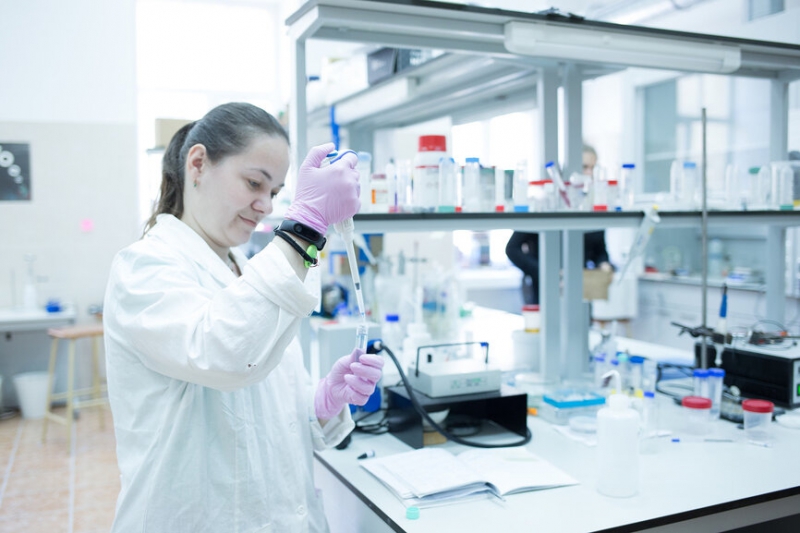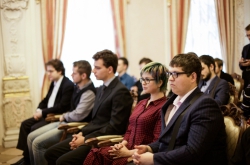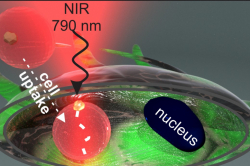George Zograf, PhD student, Faculty of Physics and Engineering
My research concerns the development of dielectric nanoparticle-based thermo-optically destructible capsules with a direct temperature response, which are intended for targeted drug delivery. Systems based on polymer microcapsules are actively used for targeted drug delivery purposes, in a manner similar to that in which regular drugs are contained within capsules.
One of the possible ways of releasing the active substance from a capsule is thermally-induced destruction, namely the local overheating of the capsule’s walls. This can be achieved by embedding the capsule with nano-scale objects capable of effectively absorbing light and converting it into heat, which is what destroys the capsule. However, until today we haven’t had a system capable of tracking a capsule’s local temperature in real-time. That is necessary to properly release the drug material and prevent overheating of the nearby living cells. Such a “direct temperature response” is possible thanks to enhancing the capsule walls with nanoparticle semiconductors that exhibit an intense thermosensory signal of combination (Raman) scattering. When subjected to laser radiation, the nanoparticles, along with hearing up, will also scatter the Raman signal, the spectral properties of which can be used to measure temperatures with high precision.
Some research in this area has already been done. For instance, we’ve worked with our colleagues from ITMO’s Research Center for Nanophotonics and Metamaterials on theoretical calculations related to optically-induced heating, as well as produced and classified a series of semiconductor nanoparticles. My colleagues have also conducted joint studies and projects with the staff of Pavlov First State Medical University of St. Petersburg, which will have a positive impact on the success of our project.

This grant will help me focus on the practical applications of the fundamental research carried out as part of my PhD thesis and my work at the Center for Nanophotonics and Metamaterials. Of course, we’d like to take the project all the way from an idea to direct practical applications, but there are a number of obstacles. We also plan to acquire a patent for this invention in the course of our research.
Aleksandra Paramonova, second-year Master’s student, ChemBio Cluster
My project involves the development of scleroprotein-based, optically-active hybrid materials. Its result should be a biocomposite material based on natural scleroproteins and modified with optically-active nanoparticles in order to be used as a visualizing agent in medicine. Scleroproteins are natural fibrous proteins noted for their high level of flexibility and durability. By using webs, a natural source of scleroproteins, we can ensure that the material is not only optically active, widely applicable, and highly durable, but also biocompatible, biodegradable, renewable, and non-toxic.
The resulting composite can be used to create materials for targeted drug delivery via micelle and capsules; the sorption of these carriers can be tracked thanks to their opticity. The composites could also be used to construct angioprostheses, which are vessel prostheses used by vascular surgeons.
The result of this project will be a specialized, finely-tuned biomaterial for a wide range of uses in biomedicine. A prototype sample of the material has already been produced; in order to do that, it was necessary to develop a method of synthesizing optically-active biocompatible nanoparticles and select the optimal conditions. Nevertheless, it will be necessary to conduct further studies on the optimization of biocomposite production.

Organic fibrous composites have a number of advantages over their synthetic counterparts. Due to the lack of domestic-made organic composite materials on the Russian market, their place was taken by synthetic composites, which are produced from non-degradable materials and use highly toxic reagents.
There are no instances of industrial production of spider silk-based materials in the world today. This technology will make it possible to set up low-cost production of such materials. The resulting composite materials can be used to produce angioprostheses for patients with severe artery blockage, something that can’t be done using synthetic materials.
Igor Lashkov, researcher at the Information Technologies and Programming Faculty
My project concerns the creation of a system that monitors a driver’s physical condition while driving by analyzing their biological indicators via wearable tech. The end result will be a mobile app that you can install on your smartphone in order to detect drowsiness or aggressive driving patterns. The app can also provide context-based suggestions to the driver in order to reduce the likelihood of an accident.
Before use, the driver would position their phone to face the phone’s camera and sync up their wearable devices. The data collected by the wearables will increase the efficiency with which the app detects possible dangers.

What makes this project unique is that it uses low-cost software, in the form of a smartphone and a smart watch/bracelet/etc., to ensure road safety. This project was prompted by the limits imposed by the existing active safety systems, such as the lack of individualized settings or context-based suggestions.
A prototype version of the Android app has been developed and is available on Google Play; the app can already detect drowsiness and lack of attention using a phone’s front-facing camera and various sensors. In future iterations of the app, smartphone sensor data and data supplied by wearable tech will be combined in order to maximize the precision and efficiency of the software.
Ilya Shilov, second-year Master’s student, Faculty of Secure Information Technologies
I’m developing a multidimensional blockchain system with applications in banking and finance. Regular blockchain, which is essentially a chain of data blocks, has a number of drawbacks that hamper its popularity outside of the cryptocurrency world. Some of the key issues have to do with scaling and data exchange between individual registries. Many projects attempt to tackle scaling by sharding the transaction database, and to conduct external transactions using sidechains. My approach is different and is based on combining a given number of blockchains into a unified system.
In a multidimensional blockchain, new chains are made as the workload on each node increases, and the nodes are split into groups that each supports a separate blockchain. This reduces the workload and enables safe external transactions between any number of registers. All of the users, meanwhile, still function within a unified system, and all changes remain transparent.
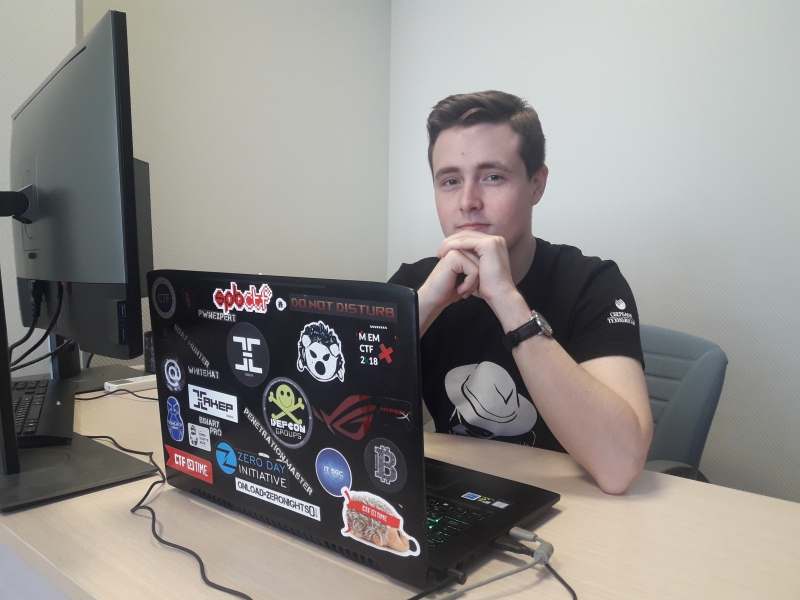
If we were to bring together financial systems into a multidimensional blockchain, we’d be able to safely conduct complex transactions between the registries of various companies and communities. Bitcoin has proved blockchain’s practical usefulness, Ethereum introduced smart contracts, ZeroCoin and ZeroCash ensured the anonymity of payment using zero-footprint cryptography, and Cardano is introducing a mathematically-proven proof-of-stake. Multidimensional blockchain, for its own part, can help achieve the same in cross-system exchange.
Many banks (JP Morgan Chase, Santander, Barclays, Sberbank, Alfa Bank) are showing interest in blockchain and investing millions in the development of projects like Enterprise Ethereum Alliance, Ripple, Corda R3, and Hyperledger Fabric. Blockchain reflects the nature of financial streams, and smart contracts allow us to take financial operations to the next level. The adoption of blockchain is impeded by the issues I’ve listed; if we solve them, multidimensional blockchain would bring nearer the use of new technologies as the framework for financial systems.
Anastasiia Yusupova, first-year Master’s student, Faculty of Control Systems and Robotics
My project involves the development of an obstacle-detecting biomechatronic unit for visually impaired people. It’s no secret that people with vision disabilities have difficulties traversing the city, and this device uses an ultrasound sensor to help them navigate better by detecting obstacles in close and distant proximity.
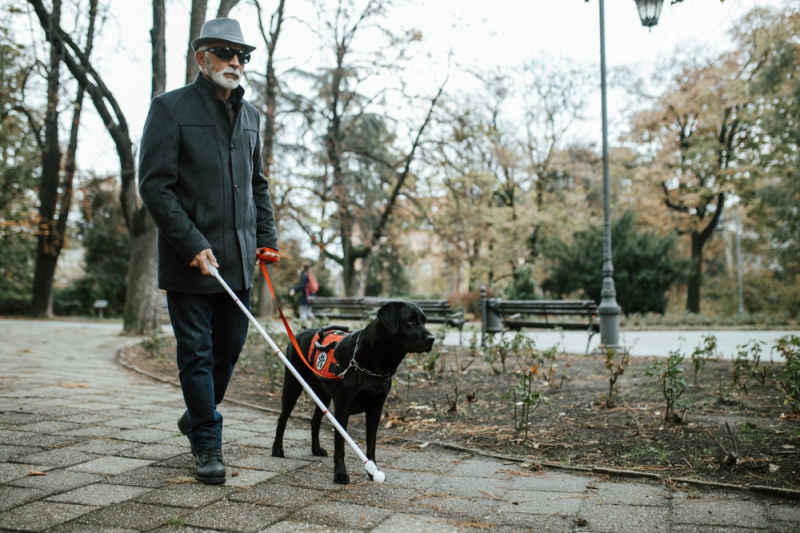
The device notifies users of nearby obstacles by vibrating: the closer an object is, the higher the frequency of vibration. There are similar devices on the market, but most of them are designed to be attached to a cane, which limits their range.
This project was initially developed for my Bachelor’s thesis, but later I realized that it can be developed into a functional prototype. This grant will help me acquire the parts necessary to complete the prototype: a better sensor, a microcontroller, and batteries. I’ll also need funding to produce the body of the unit and its circuit board.
I am collaborating with ITMO University’s Inclusive Education Office and various other social organizations in order to collect direct feedback from the device’s potential users.
